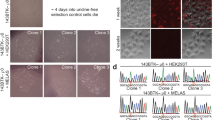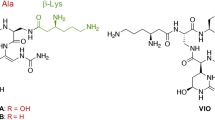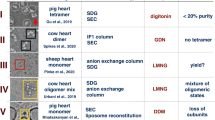Abstract
Resistance to the antibiotics chloramphenicol (CAPr) and efrapeptin (EFr) in mammalian cells is cytoplasmically inherited1,2. We demonstrate here that purified mitochondria obtained from CAPr and EFr cells are taken up by endocytosis and transfer antibiotic resistance to chloramphenicol-(CAPs) and efrapeptin-(EFs) sensitive cells. The resultant cells, termed mitochondrial transformants, are stably resistant to the antibiotics and are produced with high efficiency. The ability to transfer antibiotic resistance using mitochondria supports the notion that CAPr is due to a mutation of the mitochondrial DNA3. This technique of mitochondrial-mediated transfer of antibiotic resistance may provide a novel means for studying mitochondrial genetics in mammalian cells.
This is a preview of subscription content, access via your institution
Access options
Subscribe to this journal
Receive 51 print issues and online access
$199.00 per year
only $3.90 per issue
Buy this article
- Purchase on SpringerLink
- Instant access to full article PDF
Prices may be subject to local taxes which are calculated during checkout
Similar content being viewed by others
References
Bunn, C. L., Wallace, D. C. & Eisenstadt, J. M. Proc. natn. Acad. Sci. U.S.A. 71, 1681–1685 (1974).
Lichtor, T. & Getz, G. Proc. natn. Acad. Sci. U.S.A. 75, 324 (1978).
Kearsey, S. E. & Craig, I. W. Nature 290, 607–608 (1981).
Malech, H. L. & Wivel, N. A. Cell 9, 383–391 (1976).
Bogenhagen, D. & Clayton, D. A. J. biol. Chem. 249, 7991–7995 (1974).
Johnson, L. V., Walsh, M. L. & Chen, L. B. Proc. natn. Acad. Sci. U.S.A. 77, 990–994 (1980).
Clark, M. A. & Shay, J. W. Scanning Electron Microsc. 3, 527–535 (1979).
Wigler, M. et al. Proc. natn. Acad. Sci. U.S.A. 77, 3567–3570 (1980).
Shay, J. W. & Clark, M. A. J. supramolec. Struct. 11, 33–49 (1979).
Wallace, D. C. & Eisenstadt, J. M. Somat. Cell Genet. 5, 373–396 (1979).
Author information
Authors and Affiliations
Rights and permissions
About this article
Cite this article
Clark, M., Shay, J. Mitochondrial transformation of mammalian cells. Nature 295, 605–607 (1982). https://doi.org/10.1038/295605a0
Received:
Accepted:
Issue Date:
DOI: https://doi.org/10.1038/295605a0



